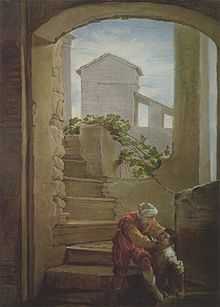Parable of the unforgiving servant

The Parable of the Unforgiving Servant (also known as Ungrateful Servant, Unmerciful Servant, or Wicked Servant but not to be confused with the parable of the Two Debtors) is a parable of Jesus which appears in only one of the Canonical gospels of the New Testament. According to Matthew 18:21-35 it is important to forgive others as we are forgiven by God, as illustrated by the negative example of the unforgiving servant.
Narrative
The parable is told as an answer to a question by Peter about forgiveness:
Then Peter came and said to him, "Lord, how often shall my brother sin against me, and I forgive him? Until seven times?"Jesus said to him, "I don't tell you until seven times, but, until seventy times seven. Therefore the Kingdom of Heaven is like a certain king, who wanted to reconcile accounts with his servants. When he had begun to reconcile, one was brought to him who owed him ten thousand talents. But because he couldn't pay, his lord commanded him to be sold, with his wife, his children, and all that he had, and payment to be made. The servant therefore fell down and knelt before him, saying, 'Lord, have patience with me, and I will repay you all!' The lord of that servant, being moved with compassion, released him, and forgave him the debt.
"But that servant went out, and found one of his fellow servants, who owed him one hundred denarii, and he grabbed him, and took him by the throat, saying, 'Pay me what you owe!'
"So his fellow servant fell down at his feet and begged him, saying, 'Have patience with me, and I will repay you!' He would not, but went and cast him into prison, until he should pay back that which was due. So when his fellow servants saw what was done, they were exceedingly sorry, and came and told to their lord all that was done. Then his lord called him in, and said to him, 'You wicked servant! I forgave you all that debt, because you begged me. Shouldn't you also have had mercy on your fellow servant, even as I had mercy on you?' His lord was angry, and delivered him to the tormentors, until he should pay all that was due to him. So my heavenly Father will also do to you, if you don't each forgive your brother truly from all his misdeeds."— Matthew 18:21-35, World English Bible

The lines before the parable itself are similar to Luke 17:3-4
The talent in this parable was worth about 6,000 denarii, so that one debt is 600,000 times as large as the other.[1] More significantly, 10,000 (a myriad) was the highest Greek numeral, and a talent the largest unit of currency,[1] so that 10,000 talents was the largest easily described debt (for comparison, the combined annual tribute of Judea, Samaria, and Idumea around this time was only 600 talents,[2] and one denarius was a day's wages,[2] so that 10,000 talents would be about 200,000 years' wages[3]). The setting is the court of some king in another country, where the "servants" could rank as highly as provincial governors.[2]
Interpretation
This parable has been interpreted in a number of ways:
- God's forgiveness of sin is of enormous magnitude, like the 10,000 talents.[2]
- This enormous degree of forgiveness should be the model for the way that Christians forgive others.[2]
- An unforgiving nature is offensive to God.[2]
- Forgiveness must be genuine.[2]
- It is like the C.S. Lewis quote, "To be a Christian means to forgive the inexcusable because God has forgiven the inexcusable in you." ― C.S. Lewis[4]
Depictions
There have been numerous depictions of this parable in art, including:
| Wikimedia Commons has media related to Unmerciful servant. |
- Domenico Fetti, Parable of the Wicked Servant (c. 1620), Gemäldegalerie, Berlin
- Willem Drost, The Unmerciful Servant (1655), Wallace Collection, London
- John Everett Millais, The Unmerciful Servant (1864), Tate Collection
See also
- Five Discourses of Matthew
- Life of Jesus in the New Testament
- Ministry of Jesus
- Was soll ich aus dir machen, Ephraim, BWV 89
References
- ↑ 1.0 1.1 R. T. France, The Gospel According to Matthew: An introduction and commentary, Eerdmans, 1985, ISBN 0-8028-0063-7, p. 277.
- ↑ 2.0 2.1 2.2 2.3 2.4 2.5 2.6 Craig S. Keener, A Commentary on the Gospel of Matthew, Eerdmans, 1999, ISBN 0-8028-3821-9, pp. 456–461.
- ↑ 60,000,000 denarii divided by 6 days per week divided by 50 weeks = 200,000 years' wages.
- ↑ "Essay on Forgiveness by C.S. Lewis". Retrieved 2011-11-18.
External links
- Biblical Art on the WWW: The Unmerciful Servant
- Parable Explained - BibleTools.org
- Parable of the Tortured Debtor - The Brick Testament
| ||||||||||||||||||||||||||||||
